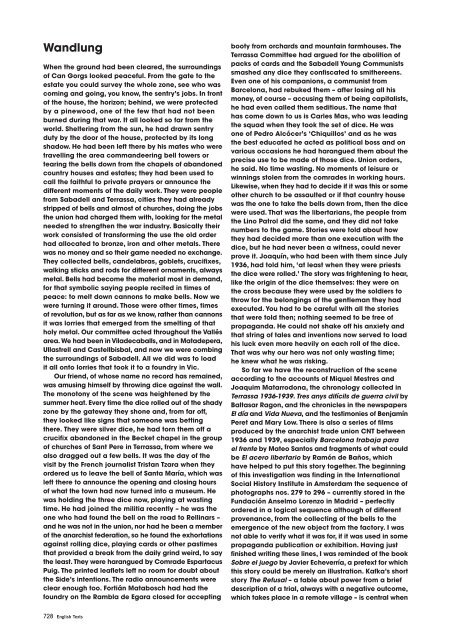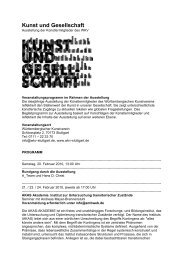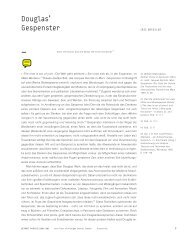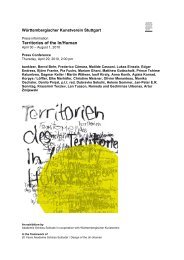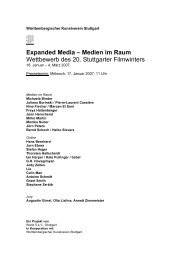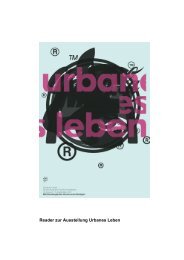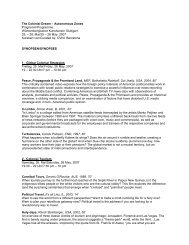English Texts
English Texts
English Texts
Create successful ePaper yourself
Turn your PDF publications into a flip-book with our unique Google optimized e-Paper software.
Wandlung<br />
When the ground had been cleared, the surroundings<br />
of Can Gorgs looked peaceful. From the gate to the<br />
estate you could survey the whole zone, see who was<br />
coming and going, you know, the sentry’s jobs. In front<br />
of the house, the horizon; behind, we were protected<br />
by a pinewood, one of the few that had not been<br />
burned during that war. It all looked so far from the<br />
world. Sheltering from the sun, he had drawn sentry<br />
duty by the door of the house, protected by its long<br />
shadow. He had been left there by his mates who were<br />
travelling the area commandeering bell towers or<br />
tearing the bells down from the chapels of abandoned<br />
country houses and estates; they had been used to<br />
call the faithful to private prayers or announce the<br />
different moments of the daily work. They were people<br />
from Sabadell and Terrassa, cities they had already<br />
stripped of bells and almost of churches, doing the jobs<br />
the union had charged them with, looking for the metal<br />
needed to strengthen the war industry. Basically their<br />
work consisted of transforming the use the old order<br />
had allocated to bronze, iron and other metals. There<br />
was no money and so their game needed no exchange.<br />
They collected bells, candelabras, goblets, crucifixes,<br />
walking sticks and rods for different ornaments, always<br />
metal. Bells had become the material most in demand,<br />
for that symbolic saying people recited in times of<br />
peace: to melt down cannons to make bells. Now we<br />
were turning it around. Those were other times, times<br />
of revolution, but as far as we know, rather than cannons<br />
it was lorries that emerged from the smelting of that<br />
holy metal. Our committee acted throughout the Vallés<br />
area. We had been in Viladecaballs, and in Matadepera,<br />
Ullastrell and Castellbisbal, and now we were combing<br />
the surroundings of Sabadell. All we did was to load<br />
it all onto lorries that took it to a foundry in Vic.<br />
Our friend, of whose name no record has remained,<br />
was amusing himself by throwing dice against the wall.<br />
The monotony of the scene was heightened by the<br />
summer heat. Every time the dice rolled out of the shady<br />
zone by the gateway they shone and, from far off,<br />
they looked like signs that someone was betting<br />
there. They were silver dice, he had torn them off a<br />
crucifix abandoned in the Becket chapel in the group<br />
of churches of Sant Pere in Terrassa, from where we<br />
also dragged out a few bells. It was the day of the<br />
visit by the French journalist Tristan Tzara when they<br />
ordered us to leave the bell of Santa María, which was<br />
left there to announce the opening and closing hours<br />
of what the town had now turned into a museum. He<br />
was holding the three dice now, playing at wasting<br />
time. He had joined the militia recently – he was the<br />
one who had found the bell on the road to Rellinars –<br />
and he was not in the union, nor had he been a member<br />
of the anarchist federation, so he found the exhortations<br />
against rolling dice, playing cards or other pastimes<br />
that provided a break from the daily grind weird, to say<br />
the least. They were harangued by Comrade Espartacus<br />
Puig. The printed leaflets left no room for doubt about<br />
the Side’s intentions. The radio announcements were<br />
clear enough too. Fortián Matabosch had had the<br />
foundry on the Rambla de Egara closed for accepting<br />
booty from orchards and mountain farmhouses. The<br />
Terrassa Committee had argued for the abolition of<br />
packs of cards and the Sabadell Young Communists<br />
smashed any dice they confiscated to smithereens.<br />
Even one of his companions, a communist from<br />
Barcelona, had rebuked them – after losing all his<br />
money, of course – accusing them of being capitalists,<br />
he had even called them seditious. The name that<br />
has come down to us is Carles Mas, who was leading<br />
the squad when they took the set of dice. He was<br />
one of Pedro Alcócer’s ‘Chiquillos’ and as he was<br />
the best educated he acted as political boss and on<br />
various occasions he had harangued them about the<br />
precise use to be made of those dice. Union orders,<br />
he said. No time wasting. No moments of leisure or<br />
winnings stolen from the comrades in working hours.<br />
Likewise, when they had to decide if it was this or some<br />
other church to be assaulted or if that country house<br />
was the one to take the bells down from, then the dice<br />
were used. That was the libertarians, the people from<br />
the Lino Patrol did the same, and they did not take<br />
numbers to the game. Stories were told about how<br />
they had decided more than one execution with the<br />
dice, but he had never been a witness, could never<br />
prove it. Joaquín, who had been with them since July<br />
1936, had told him, ‘at least when they were priests<br />
the dice were rolled.’ The story was frightening to hear,<br />
like the origin of the dice themselves: they were on<br />
the cross because they were used by the soldiers to<br />
throw for the belongings of the gentleman they had<br />
executed. You had to be careful with all the stories<br />
that were told then; nothing seemed to be free of<br />
propaganda. He could not shake off his anxiety and<br />
that string of tales and inventions now served to load<br />
his luck even more heavily on each roll of the dice.<br />
That was why our hero was not only wasting time;<br />
he knew what he was risking.<br />
So far we have the reconstruction of the scene<br />
according to the accounts of Miquel Mestres and<br />
Joaquim Matarrodona, the chronology collected in<br />
Terrassa 1936-1939. Tres anys difícils de guerra civil by<br />
Baltasar Ragon, and the chronicles in the newspapers<br />
El día and Vida Nueva, and the testimonies of Benjamín<br />
Peret and Mary Low. There is also a series of films<br />
produced by the anarchist trade union CNT between<br />
1936 and 1939, especially Barcelona trabaja para<br />
el frente by Mateo Santos and fragments of what could<br />
be El acero libertario by Ramón de Baños, which<br />
have helped to put this story together. The beginning<br />
of this investigation was finding in the International<br />
Social History Institute in Amsterdam the sequence of<br />
photographs nos. 279 to 296 – currently stored in the<br />
Fundación Anselmo Lorenzo in Madrid – perfectly<br />
ordered in a logical sequence although of different<br />
provenance, from the collecting of the bells to the<br />
emergence of the new object from the factory. I was<br />
not able to verify what it was for, if it was used in some<br />
propaganda publication or exhibition. Having just<br />
finished writing these lines, I was reminded of the book<br />
Sobre el juego by Javier Echeverría, a pretext for which<br />
this story could be merely an illustration. Kafka’s short<br />
story The Refusal – a fable about power from a brief<br />
description of a trial, always with a negative outcome,<br />
which takes place in a remote village – is central when<br />
728 <strong>English</strong> <strong>Texts</strong>


